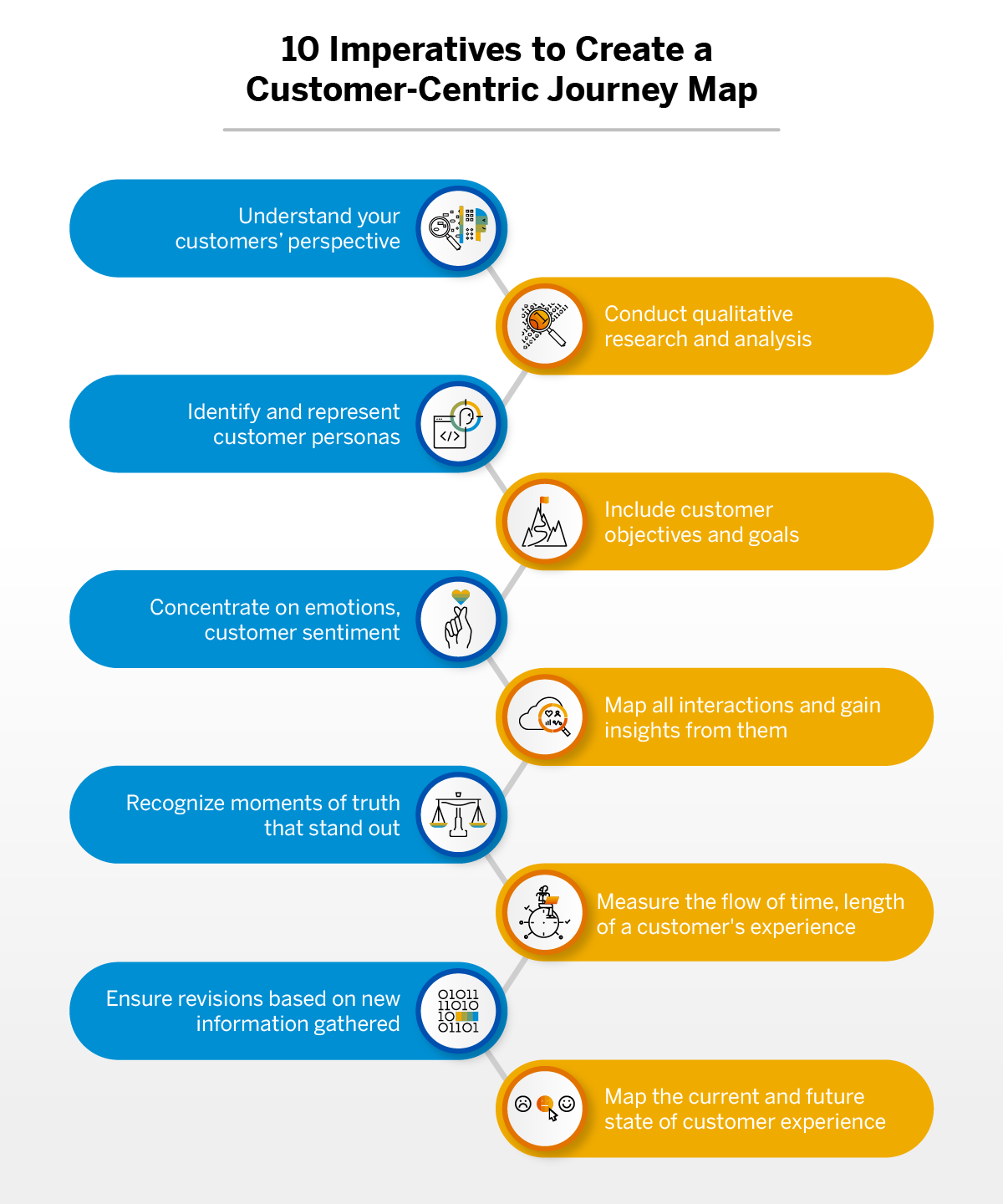For any business to succeed in today’s fiercely competitive landscape, it is crucial to provide its customers with the best experiences. Consistency of service and experience across channels is nearly impossible until you manage the customer’s journey across new channels, devices, applications, and more. To do so, it is essential to understand the customer journey- how they act when they visit your store or browse your website, and what you can do to improve their experience, so they return.
Traditionally, this approach was siloed, with departments such as product, customer service, sales staff, or marketing looking at only their part in the customer’s journey. This compartmentalized approach to individual touchpoints overlooks the bigger—and more important—picture: the customer’s overall experience. You can only begin to comprehend how to meaningfully increase performance by looking at the customer’s experience through his or her own eyes.
For example, when popular audio streaming service Spotify wanted to improve its customers’ musical experience, it hired a marketing company to map its customers’ journeys. The goal of this customer journey map was to:
- Increase number of users
- Improve the experience of sharing music for current users
- Improving the music sharing feature and increasing its adoption
The map included all the user experiences — from the moment they start using Spotify on a mobile device to asking if they like a song shared by a friend. At each step, data is collected on what the customer is interested in, what they are thinking about, and what they are feeling.
Based on this, Spotify made changes to its functionality, tweaked the interface to make the music sharing experience smoother and more seamless and thus encouraged more users to share music with their friends and acquaintances. Needless to say, this also led to an increase in profits for Spotify.
Why does Every Business Need a Customer Journey Map?
According to a recent study conducted by Salesforce, customer experience strategies are more significant than ever. The UK-based research revealed that:
- 80% of new-gen customers placed as much weightage on their interactions with companies as on the products offered.
- 69% of customers wanted to communicate with a firm in real-time.
- 60% of consumers expected their customer experience to be connected.

By using a customer journey map to analyze user behavior, an enterprise can better understand how their customers travel through the sales process and how they feel at each step. If organizations provide the customer with the finest experience from start to finish, it will lead to increased customer satisfaction, higher sales and retention, lower end-to-end service costs, and improved employee morale. Thus, customer journey maps help:
- Increase consumer engagement
- Remove ineffective touchpoints from the equation
- Shift from a company-centric to a customer-centric mindset
- Bridge interdepartmental gaps.
- Target specific client personas with marketing initiatives that are appropriate to their identities
- Recognize circumstances that may have resulted in quantitative data abnormalities
- Assign ownership of multiple client touchpoints
- Make it feasible to calculate the return on investment for future UX/CX investments
- Optimize a client’s onboarding process through the feedback shared by customers
- Convert prospects to loyal customers in a faster and easier manner
How to Create Customer Journey Maps?
To leverage the benefits of customer journey mapping, it is advisable to start as early as possible. This can prevent the possibility of customer dissatisfaction at the later stages (which are more complex) of the journey.
However, there is no ‘standard map’ that can represent every consumer’s journey, simply because there is no such thing as a ‘standard’ client experience. An ideal journey map must be completely personalized, aligned with the customer’s profile and created from the customer’s perspective. This enables the organization to determine the focus points for future modifications as well as evaluate the efficacy of the current experience strategies.
Here is what organizations must do to create a truly customer-centric journey map:
-
Understand your customer’s perspective:
Listening to your customers is essential. The best customer journey maps represent the customer’s perspective — regarding the kind of service they want, the problems they face with the current product, what they expect from the company, etc.
For example, suppose your potential customers look for you at trade fairs, and you keep on advertising in the newspapers. In that case, the advertising budget is unlikely to deliver the kind of results the company is targeting. Representing the customer’s perspective permits the organization to focus on more successful relationship-building initiatives rather than squandering resources on programs that weren’t truly benefiting their results – or their bottom line.
-
Conduct Research and Analysis:
Extensive and qualitative customer research is required to prepare your customer journey map. To figure out what’s really going on, you’ll need interviews, ethnographies, focus group discussions, surveys, and/or other sorts of customer research, depending on the extent of the journey. In some specific cases, employees can also be asked to interact with customers to build the map. This strategy works best for B2B organizations that focus on a specific process. Some companies hire consumers to develop maps, but in this case, efforts are needed to avoid any bias related to sample size. Brands can also identify areas of improvement through customer ratings and feedback.
A company can get genuine feedback about consumer experiences through face-to-face interaction at multiple checkpoints. Apart from obtaining accurate data, this exercise also helps make the brand’s customers understand that the enterprise is going the extra mile to fulfill their requirements.
-
Identify and Represent Customer Personas:
When we talk about creating personas, we do not mean micro-segmentation; instead, we’re looking for the top two to four core consumer personas that the brand serves. Marketers can design a customer journey map for each persona and customers will then be segmented based on their demographics, lifestyle, and interests.
For example, while evaluating how customers spend on health insurance, a customer mapping exercise discovered two different types of users. While one group spent only a few hours researching, the second set of customers spent six weeks for the same, on average, and came up with several methods or options for spending on health insurance. A good customer journey map cannot combine the two segments as the outcome would not adequately reflect each segment’s experience.
-
Include Customer Objectives:
A good journey map represents what the customer wants or is looking for and also whether these goals change over the course of the journey.
For example, if the organization in question is a supermarket chain, it can have two different types of customers:
- Brings a list and sticks to it- This kind of customer does not want to be disturbed and wants to just find the goods as per the list.
- Open-minded- This customer might want to explore the supermarket and try out new goods.
Both sets of customers have different expectations from the company. Creating a journey map lets you develop cost-effective strategies to suit the demands of each group.
-
Concentrate on Emotions:
Customer sentiments are essential to any corporate organization, whether small, medium, or large. It has been proved that emotionally connected customers are much more valuable than highly satisfied customers. These emotionally connected customers buy more of your products and services, visit you more often, exhibit less price sensitivity, pay more attention to your communications, follow your advice, and recommend you more. Conversely, if the customers develop negative emotional connections with the offered products or services, it’s hard for them to forget these problems, which affects the rest of their journey. One of the primary purposes of journey mapping is to eliminate or mitigate such issues.
-
Map all interactions:
Each time the customer interacts with your brand, you get new information to add to your customer journey map. Planning the journey at every stage of your customer’s experience — including gaining brand awareness, acting on buying motivation, displaying loyalty and advocacy – lets the organization maintain records of, and gain insights from, each interaction. Not only does this help to understand the customer’s point of view, both positive and negative, it also allows the prediction of their future reactions towards the organization’s products or services.
-
Recognize Moments of Truth that Stand Out:
Moments of truth are important moments in a customer’s journey when a significant event occurs and a brand opinion is established. Simply said, these are the points at which your clients will either fall in love with your product or reject it and depart. They are vital to an organization since they can represent the weakest part of the customer journey and fix it. Not every touchpoint is a moment of truth- some touchpoints are more critical than others. For example, if a supermarket chain does not offer parking, it is highly possible that the customer chooses not to visit the supermarket at all. In this case, parking is much more important than other touchpoints. Thus, an organization needs to understand crucial touchpoints and incorporate these in the customer journey maps. This helps ensure the customer has a positive experience at those touchpoints.
-
Measure the flow of time:
The length of a customer’s experience is crucial information. Is a normal customer call taking 2 minutes or 10 minutes? Did the customer think about the product for 20 minutes or 40 hours before making a purchase? Time is an important factor in customer journey mapping.
Remember, it’s critical research to learn more about customer motivations and hurdles. If you do not have the data to answer these questions, you might need to make assumptions that may lead to inadequate strategic planning later. A good customer journey map recognizes the importance of every bit of information.
-
Revisions based on new information:
When it comes to improving the customer experience, the process is iterative and there is always room for improvement. One of the main customer experience strategies is to continue to learn about your customers. Reassess your data, receive feedback, leverage the insights and adapt and improve. Regardless of how big or small they are, the changes you make will be crucial because they are directly related to the pain points that the customers flagged.
-
Map the current and future state:
Start organizing your data and touchpoints to map the current state of your customer experience. Mapping the current state will also help you identify gaps or red flags in the experience, information duplication, inadequate transitions between phases, and any significant weaknesses and obstacles in your customer’s journey. You can then easily map potential solutions and compare the current state of the customer journey to the ideal future state. Present your results to the entire organization to keep everyone informed about the areas that need to be improved, as well as a clear roadmap for planned change and how their responsibilities will contribute to improving the customer journey.

Customer Journey Maps are valuable for understanding what brand consumers are doing and experiencing as they traverse each point of interaction. It allows businesses to minimize bottlenecks and optimize customer journeys while simultaneously enhancing their consumers’ satisfaction levels. Several customer mapping tools introduced by SAP aim to assist with your customer experience and make the necessary adjustments to attract and retain customers.



